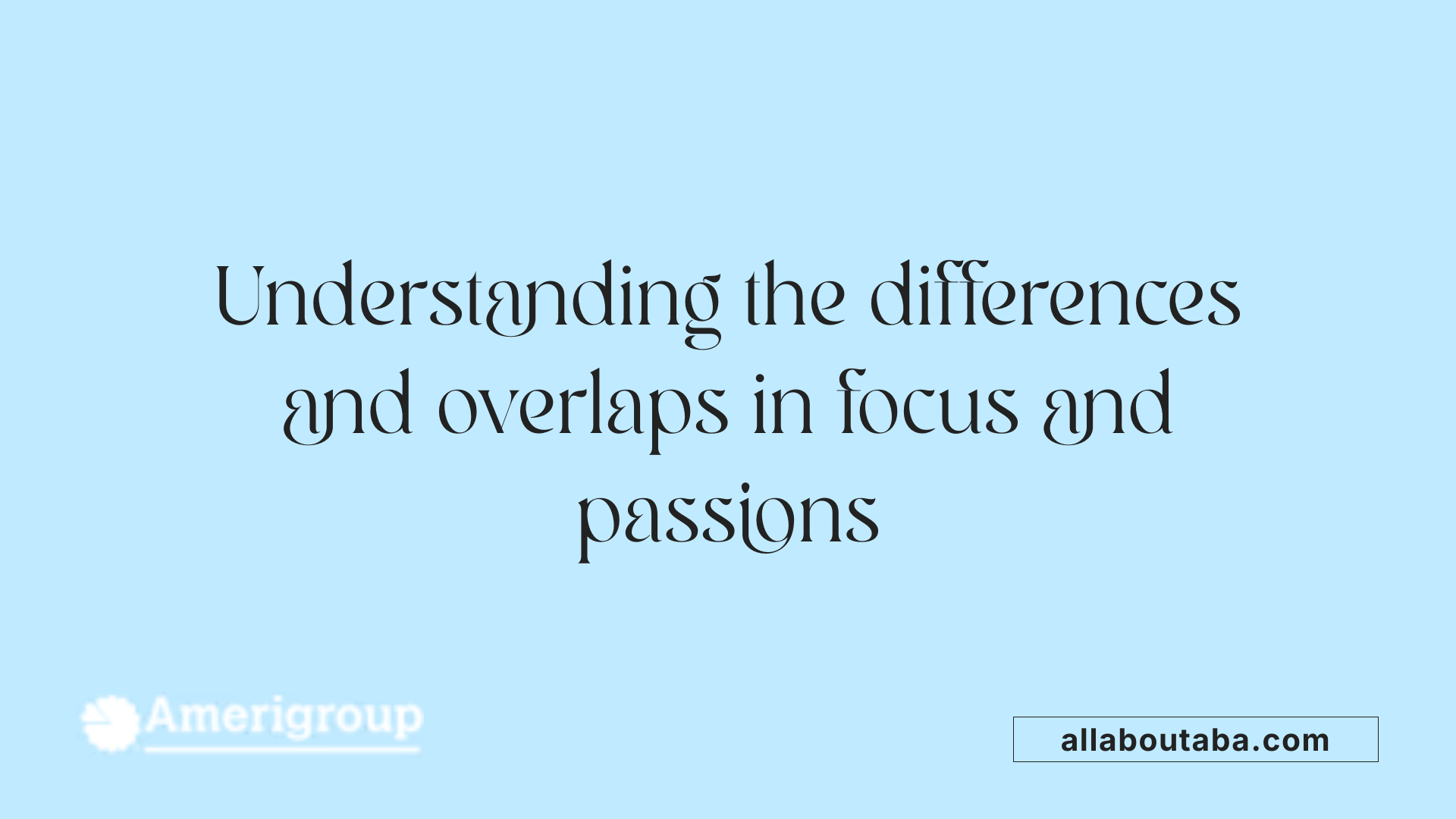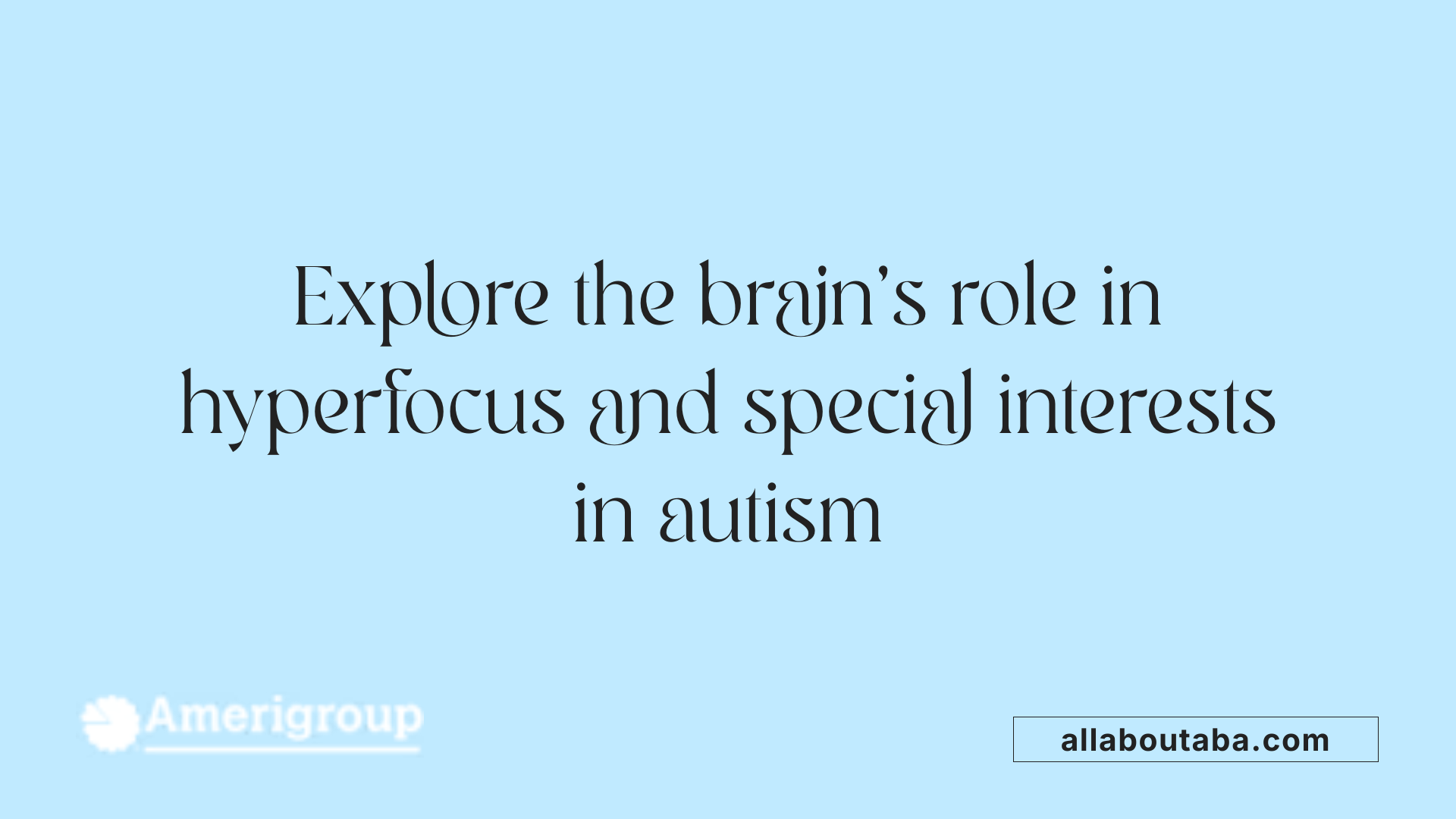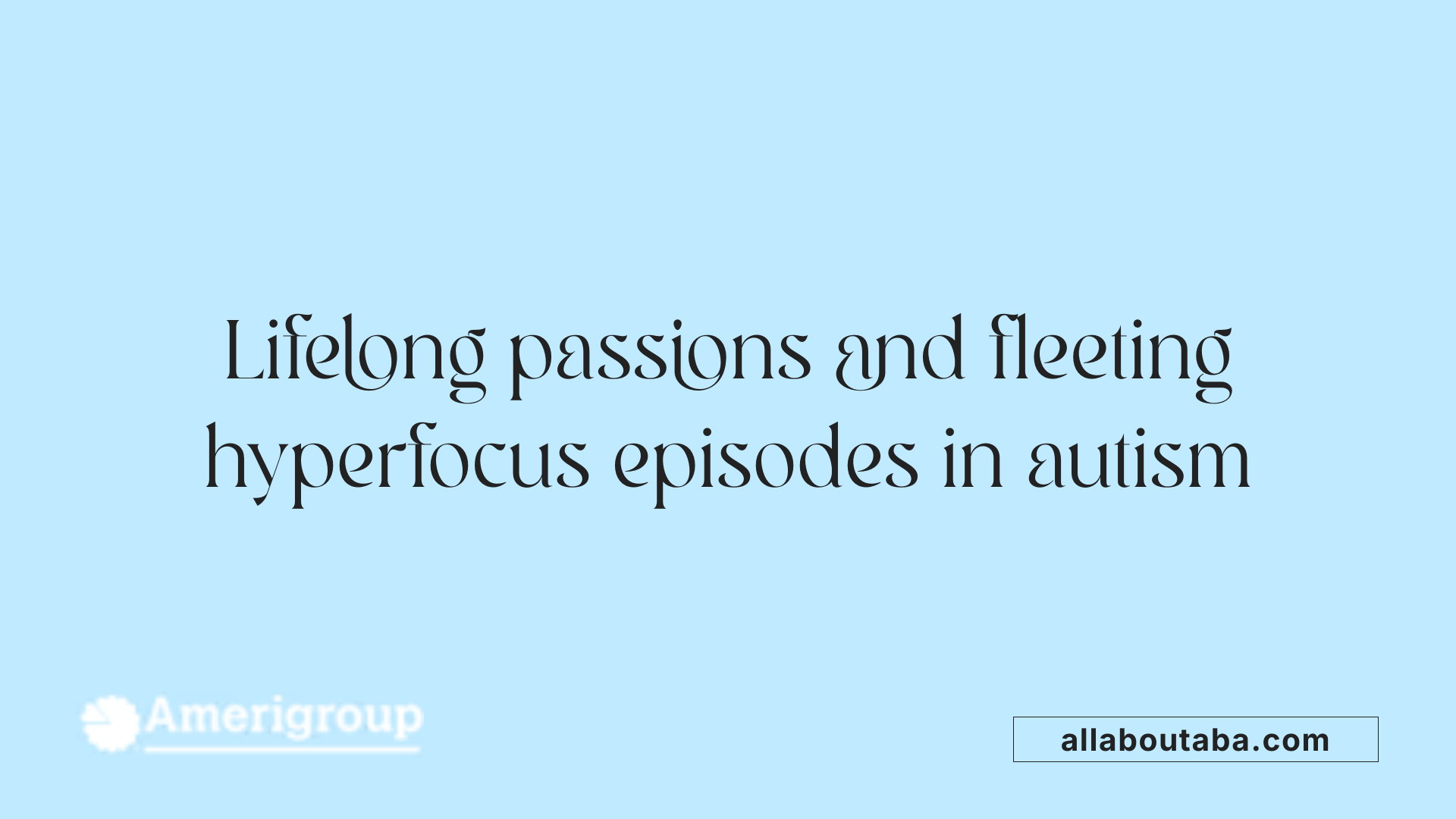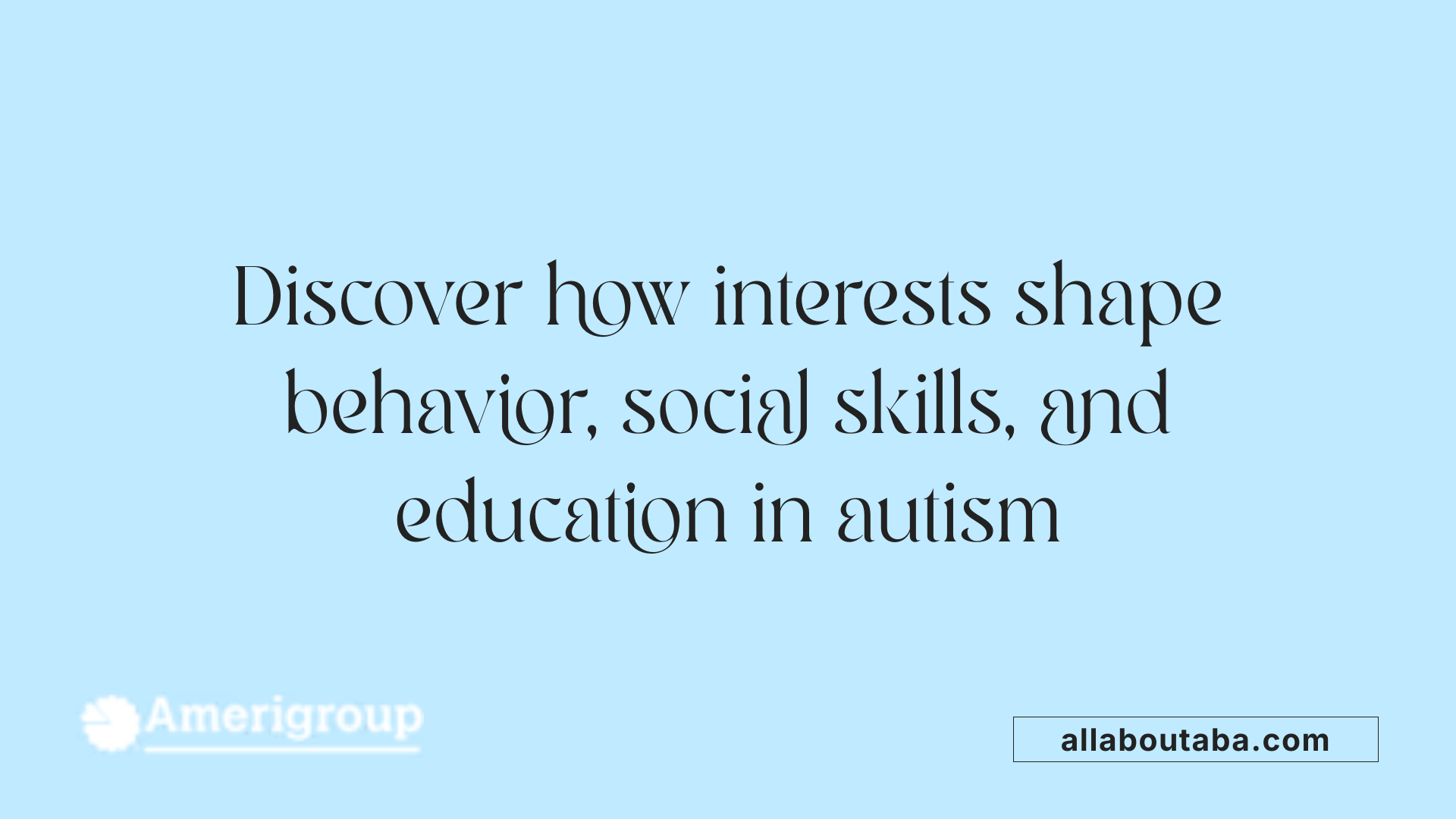Understanding Hyperfocus And Special Interests In Autism
Unveiling the Complexities of Attention and Passion in Autism Spectrum Disorder
Understanding hyperfocus and special interests is crucial for appreciating the diverse ways individuals with autism experience and interact with the world. These phenomena are not merely quirks but integral aspects of neurodivergent cognition, influencing behavior, development, and social engagement. This article delves into their definitions, characteristics, neural mechanisms, and their profound impact on life and learning, emphasizing how recognizing and harnessing these intense focus states can support well-being and personal growth.
Defining Hyperfocus and Special Interests in Autism

What is the difference between hyperfocus and a special interest in autism?
Hyperfocus is an intense, involuntary concentration on a specific activity or topic that often lasts for hours, days, or weeks. During hyperfocus, individuals become fully absorbed, sometimes losing awareness of time, basic needs, or social cues. It is usually task-specific and temporary, triggered by engaging activities such as drawing, coding, or exploring a favorite subject.
On the other hand, a special interest is a long-term, highly focused passion that becomes a central part of a person’s identity. These interests often develop over years and can sustain a person’s engagement for a lifetime. They encompass a broad area of knowledge, collection, and participation, often shaping career paths or social groups. Unlike hyperfocus, which is episodic, special interests are persistent and deeply integrated into daily life and emotional well-being.
In summary, hyperfocus is characterized by its temporary, intense immersion in an activity, whereas a special interest represents a sustained, long-lasting passion that impacts personal development and social connection.
What are the defining characteristics of special interests in autism?
Special interests in autism are marked by their intensity and the all-consuming nature of engagement. Individuals feel compelled to dedicate significant time and effort towards these pursuits, often becoming experts and collecting related items. These interests are not just hobbies but are essential for emotional regulation, providing predictability and stability in an otherwise overwhelming world.
Autistic individuals often demonstrate deep knowledge and enthusiasm about their interests, which can range from commonly shared subjects like animals or sports to niche topics like medieval weaponry or bird migration. These interests may be used as social tools to connect with others who share similar passions, promoting social bonding.
While some interests may be more typical, such as sports or music, others can be highly unique or idiosyncratic, especially in girls and women with autism, who might mask their interests to fit in better socially.
Support may be necessary if these interests interfere with essential daily activities or cause distress—highlighting their significance in understanding and supporting autistic individuals.
How do hyperfocus and special interests differ and overlap in autism?
Both hyperfocus and special interests involve deep, intense engagement. Hyperfocus tends to be short-term, episodic, and task-specific, often triggered by engaging or stimulating activities. It can lead to remarkable skills and knowledge in a narrow area but may cause neglect of basic needs or responsibilities.
Special interests, by contrast, are long-term, lasting years or even a lifetime, and are a core part of personal identity. These interests influence a person’s routines, social interactions, and career choices. Individuals with autism often share their special interests enthusiastically and use them as a social bridge.
Overlap exists because both involve an intense level of focus, skill development, and passion. For example, someone might hyperfocus on learning about dinosaurs during a certain period but maintain a lifelong special interest in paleontology.
While hyperfocus is more common in ADHD, it can occur in autism as well, and both traits can be present simultaneously, making it crucial to understand their nuances. Recognizing whether an intense focus is a fleeting hyperfocus or a long-term special interest helps tailor support strategies.
In conclusion, distinguishing hyperfocus from special interests involves examining the duration, motivation, and impact on daily functioning, which allows better support and understanding of neurodivergent experiences.
The Neural Underpinnings of Focus in Autism

What is known about the neurological basis of hyperfocus and special interests in autism?
Research into the brain activity of autistic individuals reveals that intense focus and special interests are rooted in unique neural mechanisms. Autistic brains often show atypical functioning in areas involved with attention, reward, and executive control.
One key brain region involved is the cingulate gyrus, which plays a part in regulating attention and emotional responses. Dysfunction in this area can impair the ability to shift attention freely, resulting in perseverative focus on specific thoughts or interests, often manifesting as hyperfocus or intense special interests.
Neuroimaging studies suggest that hyperfocus shares features with 'flow' states—deep, intrinsic engagement—possibly involving transient changes in frontal cortex activity, sometimes described as hypofrontality. This reduced activity in frontal regions may contribute to decreased self-awareness of time and surroundings during episodes of fixation.
At the same time, attention networks responsible for selective concentration may operate differently in autistic individuals. These differences enable certain attentional strengths, such as sustained attention on preferred topics, high focus, and detail orientation.
Reward processing also plays a vital role. The brains of autistic individuals often respond strongly to their special interests, releasing dopamine and reinforcing the behaviors related to these interests. This heightened reward sensitivity helps explain why engaging in special interests or hyperfocus can be highly motivating.
Finally, these neural characteristics not only explain the focus phenomena but also highlight why such interests are often long-lasting and deeply integrated into an autistic person's identity. They can be adaptive, providing emotional regulation, self-esteem, and a sense of purpose, but may also pose challenges if they interfere with daily functioning.
Attention networks and reward processing
Autistic individuals tend to have highly specialized attention networks that support their ability to concentrate intensely on specific topics. These networks involve the superior parietal lobule, frontoparietal circuits, and the salience network, which help in filtering relevant stimuli and maintaining focus.
Reward circuits, primarily involving the nucleus accumbens and ventral tegmental area, are highly responsive when individuals engage with their interests. This neural bias makes the pursuit of interests intensely rewarding, encouraging prolonged engagement.
Autistic attentional strengths and neural correlates
Studies show that autistic traits include observable strengths in attentional domains. These include sustained attention on complex tasks, excellent detail orientation, and memory for specifics.
Neural correlates of these strengths include increased activity in sensory and perceptual areas and less variable activity in prefrontal regions during focused tasks. This neural pattern supports a heightened ability to sustain attention but may also underpin rigid thinking patterns and perseveration.
Understanding these neural underpinnings helps in appreciating how focus manifests in autism. Recognizing the balance between strengths and challenges enables better support strategies, leveraging natural attentional traits for educational, social, and occupational success.
| Neural Region | Function | Associated Focus or Interest Type | Additional Notes |
|---|---|---|---|
| Cingulate Gyrus | Attention regulation, emotional processing | Hyperfocus, perseverative interests | Dysfunction linked to difficulty shifting focus |
| Frontal Cortex | Executive function, self-control | Deep concentration, flow states | Transient hypofrontality observed in hyperfocus |
| Reward Circuit (Nucleus Accumbens, VTA) | Reward, motivation | Special interests, hyperfixation | Elevated response enhances focus on interests |
| Parietal and Frontoparietal Networks | Selective attention, stimulus filtering | Sustained attention, detail orientation | Supports strength in focus and attention tasks |
Further research continues to clarify how these neural systems interact. The goal is to understand, enhance, and support the natural attentional profiles of autistic individuals, turning their focus into strengths while managing challenges effectively.
Development and Persistence of Interests and Focus

How do hyperfocus and special interests influence the behavior and development of individuals with autism?
Hyperfocus and special interests are central to understanding the behavior and growth of many with autism. These intense areas of focus often serve as safe havens, providing comfort and predictability amidst life's uncertainties.
Special interests typically develop over a long period, becoming an enduring part of an individual’s personality. These interests often start early in childhood—between ages one and four—and can persist well into adulthood. They include topics like dinosaurs, music, or niche areas such as medieval weaponry or bird migration. Because they are sustained and integrated into daily routines and social interactions, special interests foster skills, confidence, and social bonds.
In contrast, hyperfocus episodes tend to be shorter, lasting hours or days, and involve an all-consuming concentration on a specific activity or topic. Common triggers include building projects, reading, or engaging with specific media such as space or technology documentaries. While hyperfocus can seem impulsive and short-lived, it often results in skill acquisition, deep knowledge, and a sense of achievement.
Both hyperfocus and special interests are associated with positive developmental outcomes when appropriately supported. They can improve attention span, perseverance, and problem-solving abilities. Furthermore, they often assist in emotional regulation, reducing anxiety and enhancing well-being.
When these interests are shared with others, they can promote social engagement within neurodivergent communities. They also serve as tools for self-expression, helping individuals navigate social and emotional landscapes.
Supporting these pursuits through education and therapy—such as incorporating a child’s interests into learning or career planning—can significantly boost motivation and independence. Overall, these focused passions significantly shape behaviors, skills, and developmental paths, often fostering resilience and a positive sense of identity.
Are hyperfocus and special interests lifelong or transient?
Special interests in autism tend to be long-lasting, often enduring for years or even a lifetime. Many individuals report that their special interests become an integral part of who they are, influencing their career choices, hobbies, and social circles. For instance, some may turn their fascination into a profession—like Satoshi Tajiri creating Pokémon or Stephen Wiltshire becoming a renowned cityscape artist. These interests provide motivation, a sense of purpose, and a foundation for developing expertise.
On the other hand, hyperfocus episodes are generally shorter, lasting from a few hours to several weeks or months. They are characterized by an intense concentration on a particular task or subject that can cycle in and out of a person’s life. For example, someone might hyperfocus on a new hobby, such as coding or drawing, for a specific period before shifting attention elsewhere.
While hyperfocus episodes are fleeting, they can sometimes evolve into longstanding interests if the individual continues to pursue the topic or activity well beyond the initial episode. However, their transient nature generally makes hyperfocus less stable compared to the enduring stability of special interests.
The importance of recognizing this difference lies in how each can serve developmental and emotional needs. Long-term interests can provide lasting motivation, stability, and a sense of identity, while episodic hyperfocus can catalyze rapid skill development and discovery.
In summary, special interests often serve as lifelong anchors, shaping identity and abilities, whereas hyperfocus episodes are more short-lived but can, at times, spark the beginning of a new, lasting interest. Supporting both types of focus in individuals with autism can promote balanced development, resilience, and a richer self-understanding.
Impact on Behavior, Social Life, and Learning

How do hyperfocus and special interests influence the behavior and development of individuals with autism?
Hyperfocus and special interests are powerful elements shaping the behavior of autistic individuals. These deep, lasting interests often serve as sources of comfort and stability, helping manage anxiety and providing emotional regulation. They promote positive behaviors such as perseverance, attention to detail, and skill mastery.
Engagement in interests can boost confidence and reduce stress, offering a structured activity that enhances overall well-being. These interests also facilitate social interaction by offering common discussion topics, thus improving communication skills within peer groups. When integrated into daily routines or therapy, these passions can support developmental gains, including better cognitive flexibility and adaptive functioning. Essentially, they act as strengths that influence both personal growth and social engagement.
Supporting and expanding these interests can positively alter developmental pathways, fostering independence and lifelong learning.
How can hyperfocus and special interests affect social interactions?
Autistic individuals frequently share their special interests with others, which can lead to meaningful connections within autism communities. These interests often become social bridges, allowing for shared activities and discussions that enhance peer bonding.
However, if a special interest dominates conversations or becomes all-consuming, it may risk social difficulties. Others might find the intensity unusual or overwhelming, possibly leading to misunderstandings or social exclusion.
Hyperfocus episodes—extended periods of complete absorption—might also result in social withdrawal. During these times, individuals may neglect social cues, resulting in feelings of frustration or isolation.
Promoting balanced participation in interests, encouraging the sharing of diverse topics, and teaching social skills can help individuals use their passions to buildpositive relationships. Recognizing when hyperfocus is interfering with social life allows caregivers and educators to guide the individual toward healthier social interactions, leveraging interests as tools for connection.
What educational strategies can optimize learning for individuals with autism who have intense interests?
Integrating special interests into educational plans can significantly enhance learning engagement and outcomes. Tailoring curricula to include these passions makes education more relevant and motivating.
Practical strategies include designing lesson plans that incorporate the interests, such as using favorite topics in reading and writing tasks or creating projects centered around subjects the child loves.
Using visual aids, hands-on activities, or thematic unit studies aligned with the child's passions helps deepen understanding and retention. Encouraging discussions about interests not only enhances communication skills but also fosters confidence.
Structured routines with scheduled breaks prevent obsession and allow for flexibility, reducing stress and promoting balance.
Professional support through therapy or specialized education can help teachers and caregivers develop personalized approaches, turning interests into pathways for skill development, socialization, and academic success.
Managing Hyperfocus and Special Interests Effectively

What strategies can help manage hyperfocus or special interests if they interfere with daily life?
Managing intense interests such as hyperfocus or special interests requires practical strategies to ensure they support well-being without becoming overwhelming. One effective method involves setting clear boundaries and time limits. Using timers or alarms can help individuals limit the time spent on a particular activity, preventing it from extending into hours or even days.
Developing structured routines and scheduled breaks is also critical. These routines ensure that essential responsibilities, such as self-care, household chores, and social interactions, are not neglected. Incorporating mindfulness and grounding techniques can increase awareness of early signs of hyperfixation, allowing individuals to intervene before the focus becomes unmanageable.
Building a support network, including trusted friends, family, and mental health professionals, can encourage accountability and provide encouragement. Additionally, diversifying interests and hobbies can reduce the risk of over-attachment to a single activity, promoting a healthier balance in daily life.
How can environments be structured to support individuals with hyperfocus or special interests?
Creating supportive environments involves thoughtful design and routine management. Spaces should be equipped with appropriate lighting, minimal noise, and clutter-free areas to enhance concentration and comfort. Comfortable seating and readily available resources—such as tools or materials related to the person’s interests—can foster focus while preventing frustration.
Establishing predictable routines and visual schedules offers structure and assists with transitions between activities. This predictability can reduce stress and improve focus. Using tools like timers, checklists, and visual cues can facilitate self-regulation and awareness, helping individuals recognize early signs of excessive involvement.
Encouraging designated times for engaging with interests and balancing other activities ensures that hyperfocus does not dominate daily routines. Regular reflection on how activities impact mood and energy levels is also beneficial for fostering self-management.
What role does professional guidance play in managing hyperfocus and special interests?
Professional support through therapy or psychological assessment is invaluable for effectively managing hyperfocus and special interests. Therapists and other specialists can help develop personalized strategies tailored to an individual’s unique needs and challenges.
Interventions such as cognitive-behavioral techniques can teach individuals how to set boundaries, practice self-control, and utilize coping mechanisms effectively. Professionals can identify underlying causes, such as sensory sensitivities or emotional regulation difficulties, and recommend targeted interventions.
Ongoing collaboration with occupational therapists, psychologists, or behavioral therapists can promote skill development, emotional resilience, and overall adaptive functioning. This support helps ensure that hyperfocus becomes a constructive element of a person’s life, enhancing independence and well-being. In addition, guidance from professionals can assist with integrating interests into education, employment, and social interactions, maximizing their positive potential.
Embracing Focus for a Better Future
Recognizing the nuanced differences and similarities between hyperfocus and special interests in autism provides a foundation for fostering understanding and supporting neurodivergent individuals. These intense focus states are powerful tools that can serve as sources of strength, skill development, and emotional stability. By developing tailored strategies, creating supportive environments, and appreciating these traits as facets of individuality, caregivers, educators, and professionals can enhance well-being and help individuals navigate life's challenges with resilience and confidence. Embracing and harnessing these focused passions opens pathways to personal fulfillment, meaningful social connections, and successful careers, ultimately celebrating the rich diversity of the autism spectrum.
References
- Autistic Special Interests Vs ADHD Hyperfixations - Simply Psychology
- Autism and Hyperfocus: How to Harness Your Strengths Without ...
- Hyperfocus or flow? Attentional strengths in autism spectrum disorder
- Understanding and Embracing Hyperfixation in ADHD and Autism
- Special interest (autism) - Wikipedia
- Understanding Hyperfocus in Autism: What It Means and Why It ...
- Autism Special Interest: A Deep Dive Into Passion and Purpose
- Hyperfocus vs. Special Interest - Dandelion Family Counseling
- The overlap between ASD and ADHD difficulties - The Autism Service
Other articles
Recent articles

Autism And Eating Challenges Beyond Picky Eating

Best Practices For Autism-Friendly Public Transport Design

Best Ways To Foster Collaboration Between Parents And Schools For Autism Support

Supporting Autistic Children During Transitions Between Activities

The Role Of Teachers In Fostering Autism Peer Acceptance

Using Art Therapy To Support Children With Autism

Autism And Strategies For Addressing Sensory Defensiveness

Autism And The Benefits Of Structured Leisure Activities

How To Support Autistic Students During Exam Season

Autism And Goal Setting For Personal Growth

How To Use Gamification In Autism Learning Programs

How Schools Can Reduce Bullying Of Autistic Students

Early Intervention Strategies For Autism Spectrum Disorder

The Role Of Therapists In Autism Life Skills Coaching

How To Support Autistic Individuals In Crisis Situations

Autism And Self-Care Routines For Stress Management

Understanding Echolalia And Its Role In Autism Communication

Autism And Fine Arts Education Benefits

The Impact Of Multisensory Learning On Autism Education

How Family Counseling Supports Autism Household Dynamics

Best Practices For Inclusive Playgrounds For Autism

Best Practices For Autism-Friendly Shopping Centers

How Autism Affects Fine Motor Skill Development

Best Ways To Introduce Sensory Activities Into Daily Routines

How Sports Teams Can Be Inclusive Of Autistic Players

Autism And Strategies For Building Workplace Resilience

Autism And The Impact Of Hormonal Changes During Puberty

How To Support Autistic Students In Foreign Language Classes

Best Ways To Teach Money Skills To Teens With Autism

Supporting Siblings Of Children With Autism

Autism And Co-Occurring Gastrointestinal Disorders

The Role Of Art Projects In Autism Sensory Integration

How Schools Can Incorporate Sensory Break Spaces

Best Practices For Autism Sensory Regulation At School

Autism And Strategies For Teaching Organizational Skills

Understanding The Relationship Between Autism And Anxiety Disorders

Autism And Life Planning For Long-Term Care

Exploring Visual Supports In Autism Education

Ways To Encourage Social Interaction In Children With Autism

The Connection Between Autism And Dyscalculia

The Role Of Occupational Therapy In Transition Planning For Autism

The Role Of Physical Therapists In Autism Motor Skills Support

How To Teach Decision-Making Skills To Autistic Young Adults

The Connection Between Autism And Epilepsy

Best Practices For Transitioning Autistic Children Into New Schools

Autism And Time Management Challenges In Adulthood

The Role Of Visual Arts In Autism Communication Development

How To Address Tactile Defensiveness In Autism

Best Practices For Telehealth Autism Therapy

How To Help Autistic Children Develop Friendship Skills

How Schools Can Support Autistic Students In Career Prep

Best Strategies For Autism-Friendly Event Planning

Understanding Noncontingent Reinforcement In Autism Behavior Plans

How Drama Therapy Benefits Autistic Individuals

Best Practices For Autism-Friendly Fitness And Recreation Centers

Best Ways To Promote Healthy Social Media Use For Autistic Teens

How To Help Autistic Children Cope With Public Speaking

Autism And Strategies For Managing Unexpected Changes

Best Podcasts About Autism For Parents And Educators

Autism And The Impact Of Seasonal Changes On Behavior

The Role Of Diet In Managing Co-Occurring Conditions With Autism

Sleep Challenges In Autism And Practical Solutions

Best Ways To Build Daily Routines For Autistic Children

Best Practices For Supporting Autistic Entrepreneurs

Autism And Strategies For Navigating Large Social Gatherings

Adaptive Sports And Recreational Activities For People With Autism

Autism And The Benefits Of Story-Based Learning Activities

Understanding The Role Of Play In Autism Development

Autism And The Impact Of Environmental Noise On Learning

How To Create Autism-Friendly Community Spaces

Autism And Chronic Health Conditions: What To Know

The Role Of Care Managers In Autism Life Planning

How To Teach Social Boundaries To Autistic Children

How Autistic Individuals Experience Empathy Differently

How To Support Autistic Employees In Remote Work Settings

Autism And The Relationship Between Motor Skills And Learning

How To Create Community Resource Guides For Autism Families

How To Teach Daily Living Skills To Autistic Teens

Autism And The Impact Of Mind-Body Practices On Stress Reduction

Autism And The Benefits Of Outdoor Group Activities

How To Create Autism-Friendly Sensory Paths In Schools

Best Practices For Autism-Friendly Park And Recreation Areas

Autism And Strategies For Reducing School Refusal

Supporting Autistic Individuals In Public Speaking

The Role Of Diet In Managing Autism Symptoms

The Benefits Of Gardening Clubs For Autism Social Development

How To Prepare Autistic Children For Dental Visits

Autism And Employment: Career Paths That Work

Best Practices For Autism-Friendly Hotels And Lodging

The Impact Of Screen Time On Autism Development

Autism Screening Tools For Early Childhood

The Role Of Physical Exercise In Autism Therapy

Best Strategies For Supporting Autistic College Students

The Role Of Technology In Autism Early Detection

Sensory-Friendly Classroom Design Ideas For Autistic Students

The Role Of Speech Therapy In Building Social Communication Skills

Best Strategies For Handling Autistic Burnout In Adults

Autism And The Importance Of Predictability In Routine

Autism And Peer Education: Teaching Acceptance In Schools

Best Practices For Sensory-Friendly Libraries And Reading Rooms
We’re All About You, Your Family, and Your Child

